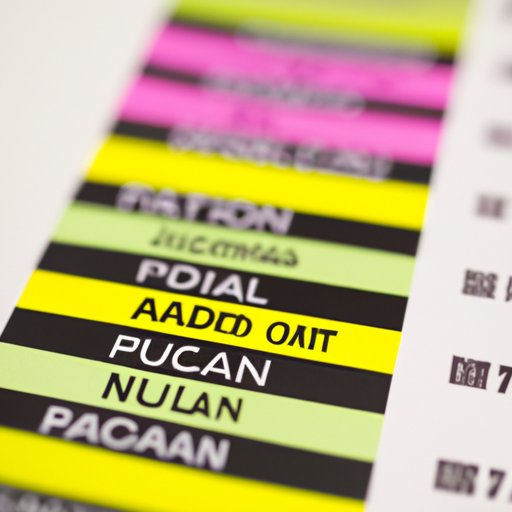Introduction
Nutrition labels provide invaluable information about the food we eat. They can help us make healthier food choices, meet dietary goals, and understand what goes into our meals. But understanding these labels can be confusing and overwhelming. This article will give a comprehensive guide on how to read and interpret nutrition labels so that informed decisions can be made about what foods to put on the plate.
Explaining Different Sections of a Nutrition Label
Nutrition labels have several sections that provide different types of information. Let’s take a look at each section in detail.
Serving Size
The first thing to look for on a nutrition label is the serving size. This tells you the amount of food or drink being measured. It’s important to note that the nutrition information listed on the label applies only to this particular serving size. If you consume more than one serving, you must multiply all of the nutritional values by the number of servings consumed.
Calories
The calorie count is the amount of energy that comes from the food or drink. Calories are essential for providing fuel to the body, but consuming too many calories can lead to weight gain. The recommended daily calorie intake varies depending on age, gender, and activity level.
Nutrient Content
The nutrient content section of the label lists the amounts of various nutrients found in the food or drink. These nutrients include fat, carbohydrates, fiber, sugar, protein, vitamins, minerals, and other substances. Nutrients are either macronutrients (which provide energy) or micronutrients (which are essential for growth and development).

Interpreting Information on the Label
Once you have a better understanding of the different sections of a nutrition label, it’s time to put this knowledge into practice. Here are some tips for interpreting the information on the label and making healthier food choices.
What is a healthy serving size?
The serving size listed on the nutrition label is not always the same as a healthy serving size. For example, if the label indicates that one serving is 1/4 cup, but a healthy serving size is 1/2 cup, you need to double the nutrition information listed. Pay close attention to serving sizes when comparing foods, as this will affect the overall nutrition content.
Understanding the ingredients list and recognizing unhealthy additives
The ingredients list on the label lists all of the components of the food or drink in descending order by weight. While it’s important to recognize healthy ingredients, such as whole grains, fruits, and vegetables, it’s also important to be aware of unhealthy additives like added sugars and preservatives. Knowing which ingredients to avoid can help you make healthier food choices.

Making Better Food Choices Using Nutrition Labels
Using nutrition labels to compare different products and identify healthier options is a great way to make better food choices. For example, if you’re looking for a snack with lower sodium, you can use the nutrition label to compare different products and choose the one with the lowest sodium content. Similarly, if you’re looking to increase your fiber intake, you can look for products with higher fiber content.

Common Mistakes People Make When Reading Nutrition Labels
Reading nutrition labels can be tricky, and there are some common mistakes people make that can lead to misinterpretations. One of the most common mistakes is not accounting for multiple servings. As mentioned earlier, the nutrition information listed on the label applies only to the indicated serving size, so it’s important to remember to multiply the values by the number of servings consumed. Another mistake is misinterpreting food labels. For example, just because a product is labeled “low-fat” doesn’t necessarily mean it’s healthy. It’s important to look at the overall nutrition content of the product, not just the fat content.
Conclusion
Reading nutrition labels is an important part of making healthier food choices. By understanding the different sections of a nutrition label and interpreting the information correctly, you can make informed decisions about which foods to put on your plate. Be sure to account for multiple servings and watch out for misleading labels. With this guide, you’ll be well on your way to making healthier food choices and meeting your dietary goals.
(Note: Is this article not meeting your expectations? Do you have knowledge or insights to share? Unlock new opportunities and expand your reach by joining our authors team. Click Registration to join us and share your expertise with our readers.)
